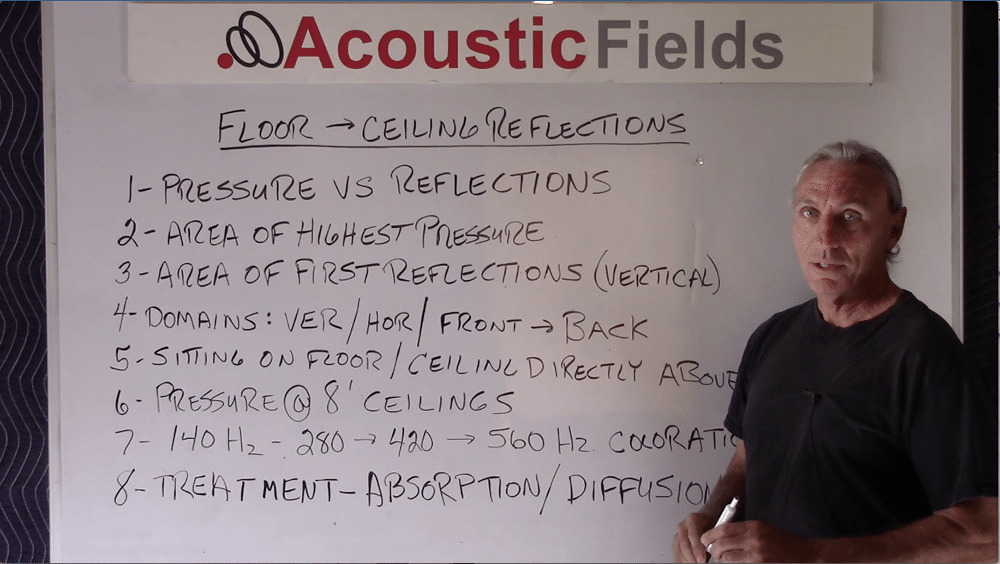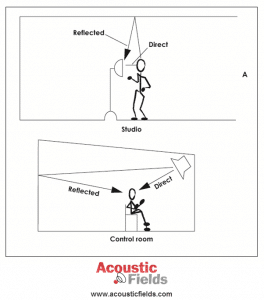Today we’re going to talk about floor ceiling reflections because they’re not discussed too much. We mainly talk about the lateral domain, sidewall reflections, but floor and ceiling reflections are really critical. We need to look at this area, and let’s take a peek and see what we can find.
Pressure vs. reflection. These are the two areas that we have to always be concerned about, low frequency pressure and then the reflections from the boundary surfaces within our room, those two domains that we have to work with just like containment and management. Those are the other two variables that we have to work with. We have pressure and reflections, containment and management. Those are our four areas of concern.
We know in North America most of our ceilings are eight foot, so it’s a very high area of pressure, because eight foot, if you do some calculations, you realize that you have some wavelengths that won’t fit in that eight-foot dimension, and that’s really important. We’ll talk about those in a minute. It’s a area of very high pressure.
It’s also an area of first reflections. People think that the sidewalls are your area of first reflections, and they are in terms of lateral domain, but this is a vertical domain. We have quite a few domains we have to look at. It’s a area of first reflections for the vertical domain. Why is that the case? Let’s go back to our domains. We have vertical, horizontal, and front to back. We have vertical, horizontal, and then front to back in our room, so we have these three dimensions of sound fields that we have to be concerned about.
You’re sitting on the floor. You can’t really get much closer to a surface than the one you’re sitting on. That’s a reflection point. That’s a boundary surface with a reflection point, so we have to be very careful with that. Ceiling, you’re sitting right below it. In North America, most of our ceilings are eight foot, so that can be an issue, too. We have to be careful with ceiling to floor reflections, and those are our closest ones. They actually arrive at the listening position first. We don’t talk about them too much, but they’re very, very important.
Why are they important? Because, first off, the pressure levels on the eight-foot ceilings. Here’s some distortions. Here’s some frequencies that distort: 280, 420, 560 with an eight-foot ceiling. These are right in the mid range of our vocals. I go into a lot of rooms and I listen, and most of the rooms, the vocals are never right. They’re never natural. They’re colored. There’s a lot of coloration in the vocals. Your eight-foot ceilings are really a good reason for this.
What’s a good ceiling height? 11′ really is a minimum. 14′ is ideal. 14’s a really great height for a drum room for you guys that do a lot of live recording out there. Keep these two dimensions in mind. This is kind of a minimum and this is ideal. Somewhere in that range for a drum room is good, and then each room also has its dictates and requirements. Keep the pressure and increase the ceiling height in your rooms if you can, because it’s a real critical area.
What are our options when it comes to ceiling treatment? One of our options is absorption and one is diffusion. Those are really the only two that we have to work with. Let’s look at absorption. You have to choose the right rate and level of absorption. It’s not just one material works in one area. You have to be very careful of this. You have to be very careful of the rate and level of absorption you use on the ceiling. You have to be very careful of the rate and level of absorption you use on the sidewalls.
Diffusion is another option. You have to be very careful once with the sequence that you choose because it’s distant-dependent. A balance between absorption and diffusion is a good combination. We use that a lot of in our rooms. We’re building a new room in Hollywood, California right now, where we’re now located. We’re using a combination of two-dimensional diffusion and absorption.
Low Frequency Management and Low Frequency Absorption
What does that do? With low frequency management and low frequency absorption, you get rid of those pressure issues that the eight-foot ceilings cause. Then you also with diffusion manage the reflections in it. Watch your ceiling heights because they’re directly responsible for what you’re hearing at the listening position, and they arrive at the listening position first.
In graphic one you can see the ceiling, the floor reflection is very critical, very, very important, so it must be treated. Then in graphic two we see the wavelengths that are affected by these eight, nine, ten, 11-foot distance. You can see by looking at the wave length chart why 11′ and 14′ is a good ceiling height to work with.
In Summary
To learn more about room acoustics please sign up to download our free ebooks and video series on room acoustics here. And please let me know if you have any questions at any time.
Thanks
Dennis Foley










Hello Dennis! If I had to choose between ceiling, floor or wall absorption in a large study room, which would be a priority? Assuming we only have one option, which would absorb more of the echo?
Thanks,
Luis
L, What is the size and usage?
The usage is mostly for tutoring and group study. There is plenty of talking and it gets noisy due to the echo. The size is 43’x32’x11.5′(LxWxH).
L, You will have to cover 60 – 70 % of the ceiling and 4 walls with treatment.
Thank you for your response Dennis! Would sound absorbing carpet be of any help? Our campus is insisting it will have a huge impact.
L, It will have a 20 % impact on a 100 % problem. Not satisfactory. Not even close.
Really appreciate the time and the feedback Dennis!